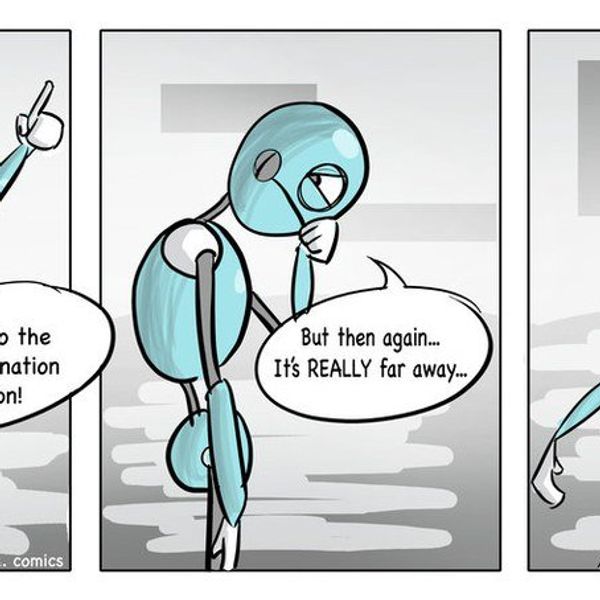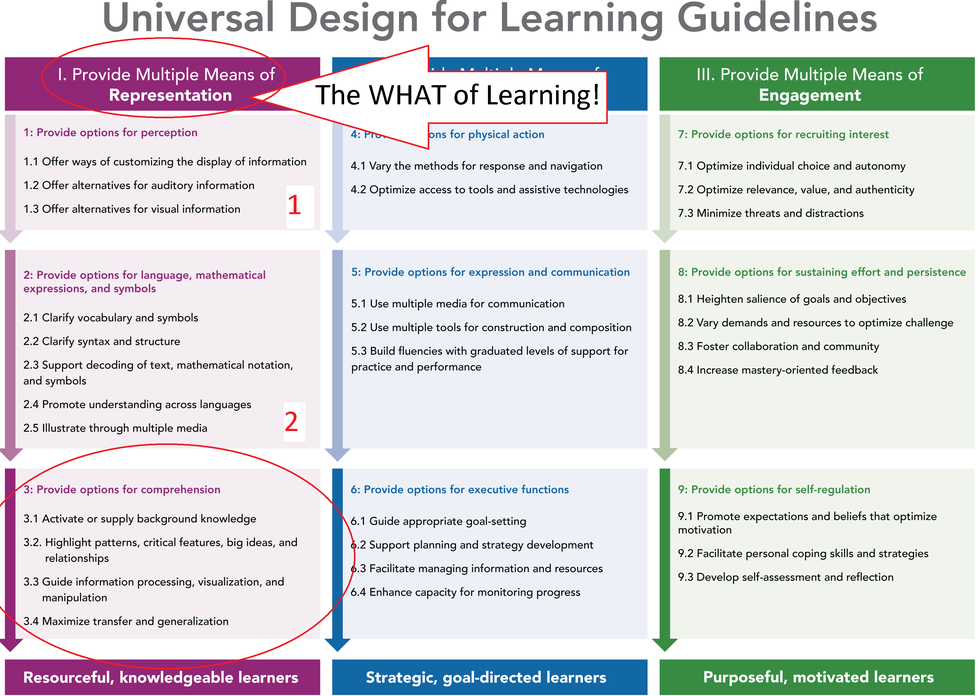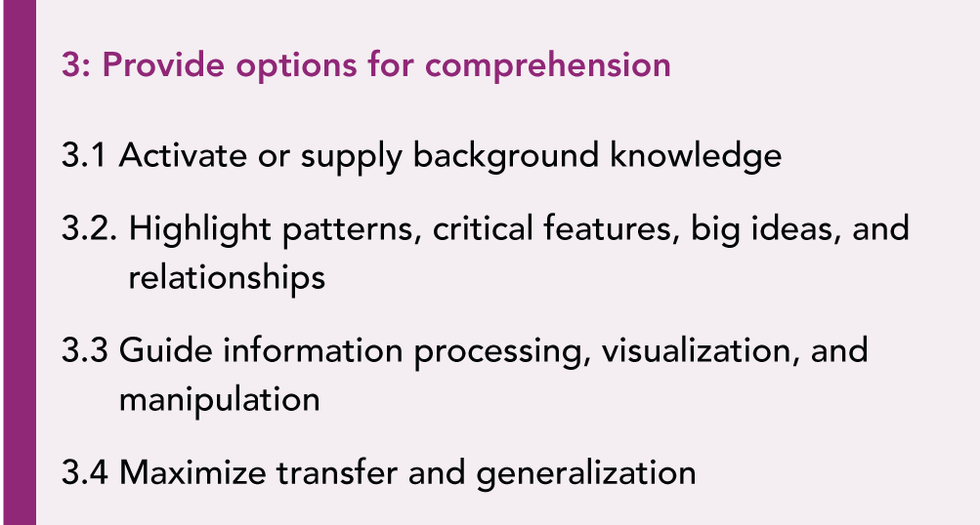We are on our third step into taking a deeper dive into Universal Design for Learning and deconstructing the guidelines! We previously looked at the overarching principle of representation and then narrowed our focus on:
Guideline One: Options for perception (please see previous article): Universal Design for Learning: Taking a Deeper Dive
Guideline Two: Options for language, mathematical expressions and symbols (previous article): Universal Design for Learning: Taking a Deeper Dive 2.
Quick Recap about UDL: Starting with the base knowledge that Universal Design for Learning (UDL) is a framework for designing and delivering instruction based on the three networks of the brain associated with learning:
1. The Recognition Network or the What of learning
2. The Strategic Network or the How of learning
3. The Affective Network or the Why of learning (CAST 20012)
The three broad networks support the three principles of UDL (I) Provide multiple means of representation; (II) provide multiple means of action and expression and (III) provide multiple means of engagement” (Rose & Meyer, 2002) and the subsequent nine guidelines (pictured above).
Now to deconstructing: We are going to stay inside the principle of representation (or the recognition network of the brain) and build on that understanding as we move to a more acute understanding of guideline three: provide options for comprehension. It is also important to note that the recognition network does not work in isolation and it is “completely intertwined with those of strategy and affect” (Meyer, Rose, & Gordon p.71).
Now let's zero in on it! (below).
With guideline three we are moving into information processing, assimilation, and synthesizing. What does that really mean?
Let’s place this guideline in context to the preceding two other guidelines that comprise the principle of representation. In guideline one, options for perception, the learner was given options to see, hear, and perceive information. This would include (but not be limited to) a variety of displays or experiences with print, digital, audio materials and/or authentic objects and spacial models. Learners then need to decode the information. Hence, options for language, mathematical expression, & symbols. Here learners need scaffolding, support, and resources for decoding, clarifying, and promoting understanding. This interaction with learning can be supported by (but not limited to) utilizing closed captioning, text to speech, visual dictionaries, charts, visual or simplified directions, vocabulary or math notation support etc.
Now the learner is ready to “make sense & understand”! So how does this guideline support comprehension?
According to Lord Nelson (p. 63), “Students demonstrate their highest level of learning when they can use what they’ve learned and apply it within other contexts. This guideline targets the essence of student development and maturity as the learner. In fact, when students are provided opportunities to operate within this guideline, they are becoming self-actualized learners.”
We could further purport that students are becoming expert learners. Thus, they are knowledgeable and resourceful!
This moves us into the What, How, and Why of guideline three: options for comprehension.
What:
Options for comprehension more simply put are options to make sense and understand knowledge. This requires information processing. Again, this is not done in isolation of the strategic and affective networks of the brain (which we will begin to deconstruct next time). This information processing occurs as learners have options for perception (guideline 1), options for language, mathematical expressions, and symbols (guideline 2) while they selectively attend to the learning experience, integrate new information with prior knowledge, categorize strategically, and actively memorize (among other things). When designing instruction, we need to attend to “what” is getting in the way. Within the context of the learning environment, barriers can exist that prevent students from perceiving, decoding and comprehending. When a lesson or learning experience demands background knowledge, time for processing, prerequisite vocabulary, grammatical syntax/structure, mathematical notations (to name a few) they must be attended to, removed, or accompany the appropriate scaffolding, support, and resources so the student can gain access to the learning outcome.
How:
By intentionally attending to barriers to learning and addressing learner variability, educators can “design” and provide learning experiences by: providing graphic organizers, offering relevant examples, chunking information, reducing irrelevant features, highlighting keywords, providing visual imagery etc.
By employing the checkpoints that guide comprehension, Novak (p. 23) reminds us that it is important to:
- Remind students what they already know about the content. If nothing, teach the necessary information.
- Make it clear what the most important information is by modeling comprehension strategies such as monitoring, highlighting, asking questions, and note taking.
- Provide work exemplars, explicit directions, and scaffolds so students can persist through the lesson.
- Help students see how they can use the new information in other classes, units, or settings.
Why:
I don’t believe students (or anyone for that matter) wakes up saying “I want to be really unsuccessful today!” Students do wake up however, feeling defeated, overwhelmed, unintelligent, unsuccessful, and uninspired. Learning has not been a good experience for many. Even for those who have complied, it hasn’t always been rewarding or challenging. Today we have the opportunity to understand learning and the neuroscience behind it in ways like never before. We have opportunities to remove barriers to learning, celebrate learner variability, engage students' funds of knowledge, and not only change our learning environments but change our students’ futures! The real question is: Will we?
CAST, Inc. (2012) Retrieved from: http://www.udlcenter.org/aboutudl/whatisudl
Meyer, A., Rose, H. D., Gordon, D. (2014). Universal Design for Learning, theory and practice. Wakefield, MA: CAST Professional Publishing.
Lord Nelson, Loui. (2014) Design and Deliver: Planning and Teaching Using Universal Design for Learning. Baltimore, MD: Brookes Publishing.
Novak, Katie. (2014)) UDL Now. Wakefield, MA: CAST Publishing.























